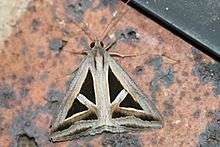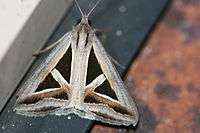Trigonodes hyppasia
| Triangles | |
|---|---|
 | |
| Scientific classification | |
| Kingdom: | Animalia |
| Phylum: | Arthropoda |
| Subphylum: | Hexapoda |
| Class: | Insecta |
| Order: | Lepidoptera |
| Family: | Erebidae |
| Genus: | Trigonodes |
| Species: | T. hyppasia |
| Binomial name | |
| Trigonodes hyppasia (Cramer, 1779) | |
| Synonyms | |
| |
The Triangles,[1] (Trigonodes hyppasia), also known as semi-looper[2] is a moth formerly of the Noctuidae family. It is largely cosmopolitan, found throughout Borneo, Fiji, India, Sri Lanka, São Tomé and Príncipe, Taiwan, Zimbabwe, Northern Australia, and almost all African countries.[3][4]
Taxonomy
The Noctuidae family of moths are mostly classified in the family Erebidae now, along with all of the former members of the families Arctiidae and Lymantriidae.[5] This re-classification has not yet met with general consensus, and many resources and publications still follow the older classification scheme (e.g.[6]).

Description
The wingspan is about 30–46 mm. Antennae of male ciliated. Mid and hind tibia hairy. Body pale ochreous brown, slightly suffused with fuscous or dark grey-brown. Fore wings with a large black white-edged triangular patch easily distinguished below the cell from near base to towards outer angle. A similar smaller patch found beyond the cell on vein 5, with some pale fulvous behind it. A slightly sinuous submarginal pale line with patches of black suffusion found inside it and a series of black specks beyond it. A dark marginal line can be seen as well. Hind wings with indistinct medial line and fuscous suffused outer area.[7]
Larva has yellow upper half and brown ventral part. Yellow part is broken by longitudinal brown bands, which faints towards posterior and becomes intensive again in prolegs. Eggs olive green and speckled rusty red. First few instars are green with three lateral purple brown lines. Late instars are yellowish. Pupa within a slight cocoon of white silk, which spun amongst leaves.[8]
The larvae feed on Chrysopogon, Eleusine Glycine, Indigofera, Kummerovia, Medicago, Phaseolus, Rhynchosia and Nephelium species.[1]
References
- 1 2 "Triangles.". African Moths. Retrieved 16 August 2016.
- ↑ http://www.ozanimals.com/Insect/Semi-looper-moth/Trigonodes/hyppasia.html
- ↑ "Trigonodes hyppasia (Cramer, 1779)". Butterfly House. Retrieved 16 August 2016.
- ↑ "Trigonodes hyppasia - Triangles". Flora of Zimbabwe. Retrieved 16 August 2016.
- ↑ Lafontaine, J. D. & Fibiger, M. 2006 Revised higher classification of the Noctuidae (Lepidoptera). Can. Entomol. 138, 610–635. doi:10.4039/N06-012
- ↑ Tree of Life Web Project. 2009. Noctuoidea. Version 10 August 2009 (temporary). http://tolweb.org/Noctuoidea/12035/2009.08.10 in The Tree of Life Web Project, http://tolweb.org/
- ↑ Hampson G. F. (1892). "The Fauna Of British India Including Ceylon And Burma Moths Vol-ii". Digital Library of India. p. 558. Retrieved 4 July 2016.
- ↑ "Trigonodes hyppasia Cramer". The Moths of Borneo. Retrieved 16 August 2016.